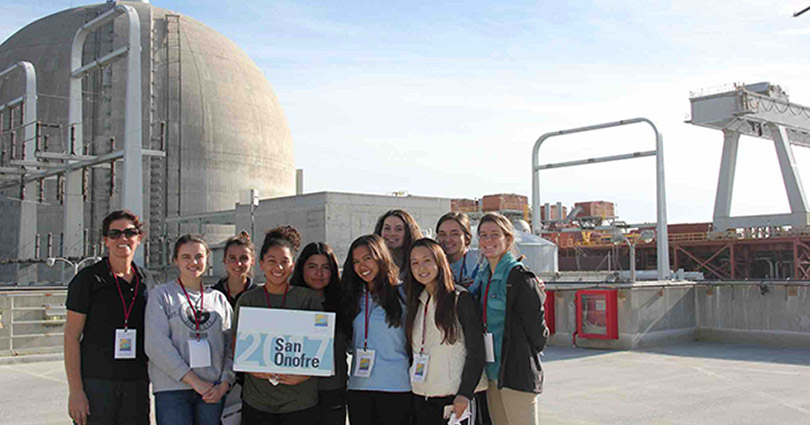By Penelope Sanchez ’19
OLP’s AP Environmental Science class recently visited the San Onofre Nuclear Generating Station. Established in 1969, San Onofre Nuclear Generating Station (SONGS) was once one of California’s greatest power generators: at its peak, it produced enough electricity to power over 1.4 million homes. Its initial success led to the creation of its second and third units in 1983 and 1984, respectively. However, in spite of all of its success in nuclear energy production, SONGS was shut down in 2013 after faulty replacement parts, which could have potentially led to leakage, were delivered to the power plant, further fueling the general public’s fears and qualms over nuclear power. The station is now property of Camp Pendleton’s Marine Corps and employs 300 people, most of whom are part of SONGS’s elite security team.
The OLP students toured the whole center, stopping at designated “learning stations” where trained professionals educated the class on everything related to nuclear power and its management.
First up was radiation, seemingly the most notorious and fear-inducing bi-product of nuclear energy. The class learned all about how radioactivity was measured and managed in order to maintain a safe working environment for all SONGS employees. Although the maximum amount of millirems of radioactivity a healthy adult can be exposed to in a year is 5,000 millirems, the average SONGS employee is only exposed to a maximum of 1000 in their working environment (about the same radiation given off by a standard CT scan), their exposure being measured every work day using a radiation dose reader. This device calculates the amount of radiation a person is exposed to by subtracting the amount of initial radiation present in the environment from the amount of overall radiation present in both a person and their surrounding environment. SONGS takes multiple safety precautions to ensure that all radioactivity is confined to the station.
Students were also introduced to SONGS’s security team and system, whose main goal, according to the (famously) alarmingly loud but overall kind Head of Security, John, is to “protect the health and safety of the public.” According to John, only former policemen, deputy sheriffs, and members of the U.S. military can apply to become part of the power plant’s security team, and must go through eight weeks of intense physical and psychological testing, as well as extensive background checks. This team is aided by SONGS’s intrusion detection system, which makes breaking into the plant nearly impossible.
Then came the pièce de résistance (at least, in the context of an environmental science class): SONGS’s Marine Mitigation Program. The MMP, also fondly referred to as SONGS’s “SEALs team,” is dedicated to “protecting and studying all sea, air, and land” currently affected or potentially affected by the production of nuclear energy and waste. The program, based in UCSB’s Marine Science Institute, monitors the environment surrounding the plant for a 100-mile radius, testing for radiological contamination, temperature, biological diversity, salinity, pH, general air quality, and crop production. The MMP also maintains a 150-mile long artificial reef, which cost $20 million to build and manage, in order to mitigate any possible environmental effects which could result from the power plant. The program also builds, as well as restores, southern California wetlands, which are surprisingly biodiverse and important to maintaining a healthy local ecosystem. Most students were surprised by the lack of major environmental disturbances reported (although the information was taken with a grain of salt, as it was given by one of SONGS’s own biologists).
Although the girls learned many new things on this trip, the biggest takeaway seemed to be that most fear of nuclear energy stems from the public’s general lack of knowledge over this potential clean-energy source. Even though SONGS has been shut down for years now, and nuclear energy may be difficult both to understand and manage, it is still important for it to be considered as a potential energy source for an ever-growing and industrialized country like the United States. Although opinions vary, there is no doubt that OLP’s APES class will continue becoming informed on nuclear energy and other energy sources.


